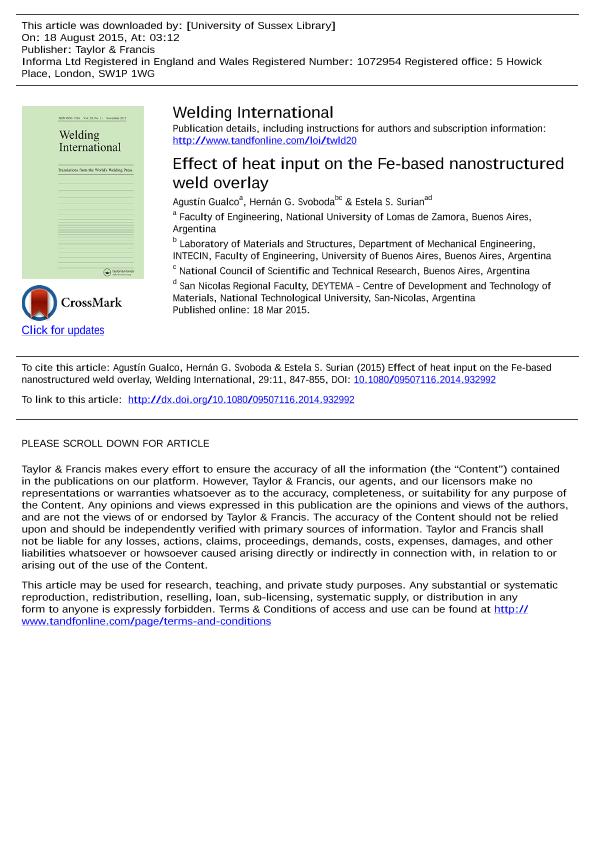Artículo
Effect of heat input in Fe-based nanostructured weld overlay
Fecha de publicación:
11/2015
Editorial:
Taylor & Francis
Revista:
Welding International
ISSN:
0950-7116
e-ISSN:
1754-2138
Idioma:
Inglés
Tipo de recurso:
Artículo publicado
Clasificación temática:
Resumen
In the last few years, several welding consumables have been developed that deposit hard iron-based nanostructured alloy coverings with high resistance to abrasive wear. The erosive and abrasive wear resistances are mainly controlled by the chemical composition and the microstructure. In turn, the microstructure of the deposited metal can show variations with the used welding procedure, particularly in relation to the heat input. The operating parameters that define the heat input (voltage, current and welding speed) affect aspects such as bead geometry (wide, penetration and reinforcement) and dilution with the base material. The purpose of this article is to study the effect of heat input on the geometric characteristics of the bead, the dilution and the microstructural evolution of a nanostructured iron-based alloy deposited by FCAW. Several samples with heat input between 0.5 and 3.5 kJ/mm were welded. A dimensional study was carried out for each welded coupon, the chemical composition was analysed and the microstructure was characterized using optical and electronic scanning microscopy and X-ray diffraction. Microhardness, crystallite size and degree of dilution were also measured. Great influence in these conditions in the process was observed about the geometry of the bead. The dilution varied between 30% and 40%; microhardness of the deposit was found between 800 and 870 HV1, and the size of the crystallite varies between 105 and 130 nm, depending on process variables used. The highest hardnesses and the lowest crystallite sizes were obtained with the lowest heat input, associated with a lower dilution.
Palabras clave:
Hardfacing
,
Welding
,
Nanomaterials
,
Heat Input
,
Hard Covering
,
Microstructure
Archivos asociados
Licencia
Identificadores
Colecciones
Articulos(INTECIN)
Articulos de INST.D/TEC.Y CS.DE LA ING."HILARIO FERNANDEZ LONG"
Articulos de INST.D/TEC.Y CS.DE LA ING."HILARIO FERNANDEZ LONG"
Citación
Gualco, Agustín; Svoboda, Hernán Gabriel; Surian, Estela Silvia; Effect of heat input in Fe-based nanostructured weld overlay; Taylor & Francis; Welding International; 29; 11; 11-2015; 847-855
Compartir
Altmétricas




